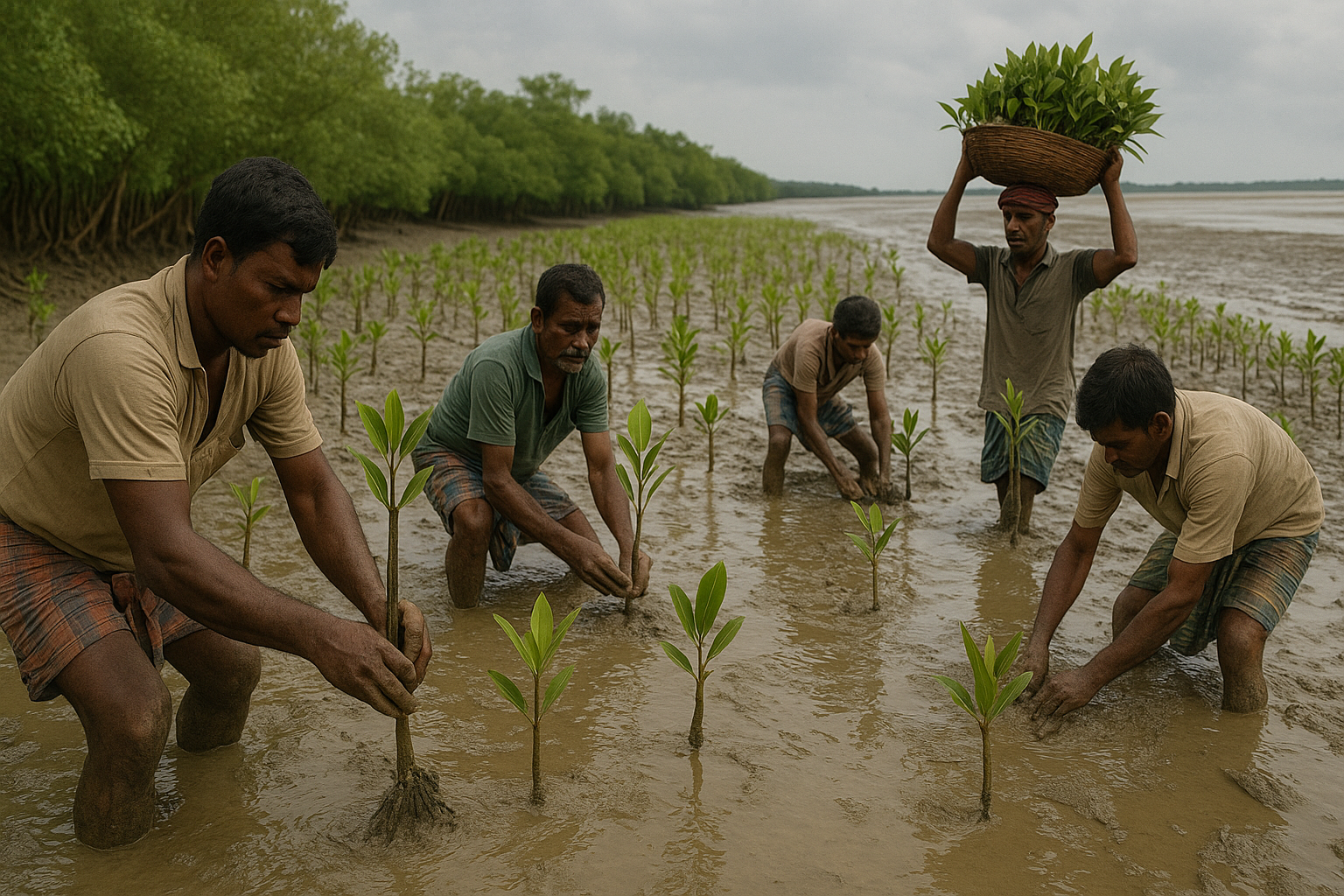Restoring Mangroves Could Transform Coastal Defense and Livelihoods in Bangladesh
A World Bank-led study finds that integrating mangroves into Bangladesh’s coastal embankments can significantly reduce flood risks, boost local livelihoods, and sequester carbon. With 255 potential sites identified, the benefits often outweigh restoration costs, making mangroves a cost-effective nature-based solution.

A new policy research working paper offers a pioneering vision for climate resilience by integrating nature-based solutions into Bangladesh’s coastal defense. Developed by experts from Delft University of Technology, Vrije Universiteit Amsterdam, Leibniz University Hannover, Invest International, and the World Bank, the study charts a compelling scientific roadmap for expanding mangrove ecosystems alongside engineered embankments. As Bangladesh faces escalating flood risks due to climate change, the research identifies 255 potential mangrove sites and estimates the environmental, economic, and structural benefits of afforestation, what the study calls “triple dividends”: disaster risk reduction, livelihood support, and carbon sequestration.
Mapping the Green Frontier: Mangrove Sites Across the Delta
Using high-resolution satellite imagery and hydrodynamic data, the researchers identified feasible mangrove restoration sites along the western (Sundarbans), central (Meghna estuary), and eastern (Chittagong) coastal zones. These sites were chosen based on tidal exposure, historical vegetation, wave dynamics, and the absence of human settlements. The central and eastern coasts emerged as particularly promising. Around Polder 45 in Amtali and the Kukri-Mukri polder, wide mangrove belts with average widths of 1.77 to 1.82 kilometers could slash the need for thick slope protection, reducing revetment thickness by as much as 80%. Similarly, the Mirersarai region and Sandwip Island in the east feature belts up to 3.5 kilometers wide, offering exceptional potential to diminish wave energy and protect embankments. In contrast, the western region near the Sundarbans mostly contains narrower belts, limiting structural benefits but still providing moderate wave attenuation.
Nature’s Economic Engine: Livelihood Benefits in the Millions
To quantify how mangroves boost local economies, the study applies a meta-analytic valuation approach using data from over 380 studies compiled in the Ecosystem Services Valuation Database. This model estimates the provisioning services of mangroves, such as fisheries, timber, fuelwood, and eco-tourism, in standardized terms (USD per hectare per year). Adjusted for population density, GDP per capita, and land protection status, the study finds that mangrove restoration could deliver an average present value of $22,000 to $30,000 per hectare over 29 years. These benefits are most substantial in the eastern zone due to both the larger patch sizes and higher local demand for resources. On a regional scale, average aggregate benefits amount to $0.1 million in the west, $3 million in the center, and a remarkable $9 million in the east. The potential for these restored ecosystems to support sustainable livelihoods underscores the dual humanitarian and ecological rationale for investment.
Blue Carbon Potential: Climate Mitigation Takes Root
Beyond flood protection and economic returns, mangroves play a critical role in carbon sequestration. The study estimates that restored mangroves can capture approximately 14 tons of CO₂ per hectare per year, using sequestration data specific to Bangladesh. Applying the U.S. Interagency Working Group’s estimates for the social cost of carbon, ranging from $89 to $129 per ton, the analysis calculates a present value of $13,120 per hectare in carbon benefits from 2022 to 2050, discounted at 6%. The spatial distribution of carbon benefits closely aligns with patch size, meaning that the largest returns are again concentrated in the east. Although voluntary carbon markets currently yield low per-hectare revenues, the report recommends bundling multiple sites under a national registry aligned with Article 6.2 of the Paris Agreement to reduce verification costs and make carbon credits viable in the future.
From Vision to Practice: Costs, Constraints, and Recommendations
Restoring mangroves isn’t cheap, but it is cost-effective. The study places the average cost of restoration at $7,700 per hectare, drawing from global data and localized economic factors such as purchasing power parity and GDP. Impressively, in 252 out of 255 identified sites, the projected livelihood benefits alone exceed these costs, before even accounting for infrastructure savings or carbon revenue. For example, in a mangrove belt measuring 1.8 kilometers wide and 22 kilometers long, potential savings in revetment costs alone could exceed $370,000. Nevertheless, the paper emphasizes that mangroves should be seen as complementary to hard defenses, not replacements. Less than 15% of identified sites exceed the 500-meter width threshold required for meaningful wave attenuation. Moreover, implementation may face social and legal hurdles, such as land tenure ambiguity, weak community incentives, and ecological variability in tree species. The authors call for bundling restoration finance with policy instruments like community stewardship leases and producer cooperatives to ensure long-term sustainability.
The study presents an evidence-based argument for a hybrid coastal protection strategy that blends engineered defenses with ecological restoration. While challenges remain, especially regarding governance and carbon monetization, the triple dividends of mangroves, economic, protective, and environmental, offer a uniquely powerful tool for building climate resilience in one of the world’s most vulnerable regions. With strategic planning, local engagement, and global support, Bangladesh’s mangrove frontier could become both a shield and a sanctuary.
- FIRST PUBLISHED IN:
- Devdiscourse
ALSO READ
World Bank’s New Procurement Rules Require 30% Local Labor in Civil Works Contracts
World Bank Mandates 30% Local Labor in Global Projects to Boost Jobs
World Bank Urges Equatorial Guinea to Leverage Forests for Growth
NZ Backs Fiji with $7.2M for Climate Resilience and HIV Response
World Bank Scales Up Global Efforts to Combat Plastic Pollution Lifecycle










